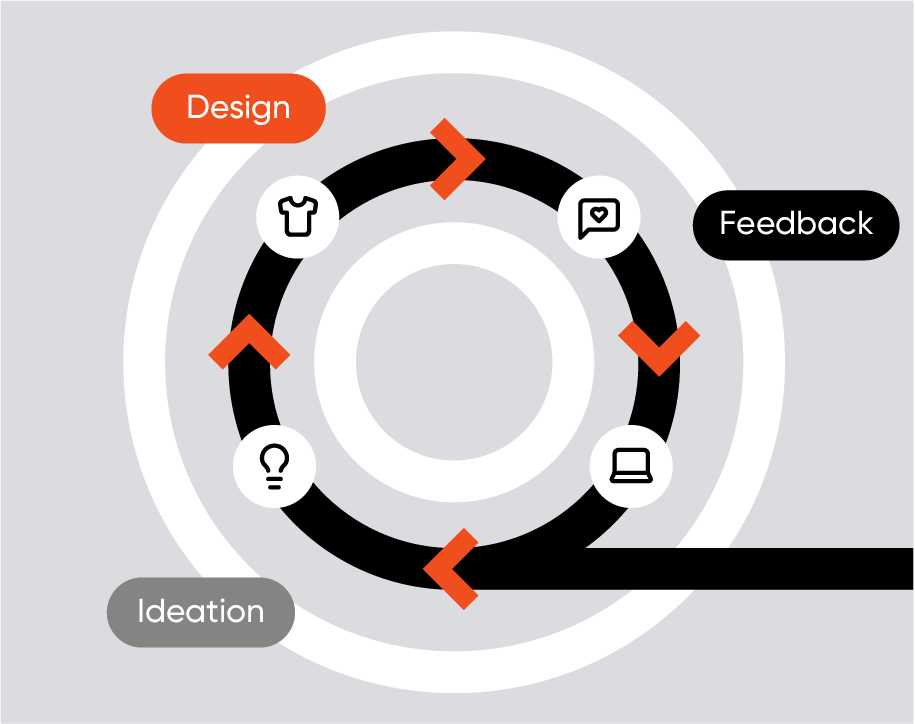Digital Supply Chains: Achieving Transparency in Fashion
Discover how digital tools like Browzwear support fashion transparency and build a more agile, efficient digital supply chain for modern brands.
May 15, 2025

In today’s volatile market, fashion companies are pressured to increase speed, reduce waste, and stay competitive, without sacrificing profitability or sustainability. Traditional linear product development models, where products move from ideation to production in a one-way flow, can no longer keep up.
Forward-thinking brands strategically shift toward circular product development, building agile, connected supply chains that enable faster decision-making, real-time collaboration, and sustainable growth.
The linear product development model follows a one-directional path: ideation → design → sampling → production → distribution → sales → end-of-life (often landfill or disposal). Each stage operates in isolation, with limited feedback loops or opportunities for reuse.

While this approach worked in slower, predictable markets, it creates significant bottlenecks and waste in today’s fast-paced environment. It leads to:
Long lead times that delay market entry.
Excess sampling and wasted materials.
Slow reaction to market changes and trends.
Higher risk of unsold inventory and markdowns.
In an industry where timing is everything, these inefficiencies create financial and operational risks.
A circular product development model replaces sequential silos with an iterative, collaborative process that connects stakeholders at every stage. Digital assets, like virtual prototypes and validated fit blocks, act as a shared source of truth across design, merchandising, and production.
This model reimagines the product lifecycle as an iterative, continuous process rather than a one-way sequence. Instead of moving step by step toward a product’s end, each phase is connected through feedback and reuse, creating ongoing improvement and reducing waste.
Feedback loops: Input from internal teams, vendors, and consumers is continuously integrated across stages.
Reuse: Previously approved assets such as fit blocks, patterns, and materials are leveraged in new collections.
Recycling: Materials or components at the end-of-life stage are repurposed into new production cycles.
Virtual prototypes: Digital samples replace many physical prototypes, speeding up revisions while cutting costs and waste.
Real-time collaboration: Teams and partners work simultaneously through digital platforms, enabling faster alignment and decision-making.
The circular model connects ideation, design, sampling, production, distribution, sales, and end-of-life in an ongoing loop, where insights and materials cycle back to earlier stages for continuous refinement.

Faster approvals and fewer physical samples.
Real-time collaboration between teams and suppliers.
Reuse of proven assets to eliminate redundancies.
Smarter decisions that reduce waste and overproduction.
Stronger alignment with sustainability goals.
Circularity isn't just about recycling materials. It’s about recycling knowledge, designs, and data to improve every product development cycle.
Leading brands achieve measurable business outcomes by moving from linear to circular product development.
For example, Perry Ellis International reduced their physical salesmen's samples by 50-75%, speeding up approvals while improving collaboration between design and sourcing teams.
Oasis, a Vietnam-based garment manufacturer, shortened their development process by over a month, which translates into more than 20% savings. This allowed them to respond faster to client needs and market shifts.
Similarly, Bonprix achieved a 50-100% reduction in fitting samples across several product groups, with some items going straight to production without any physical sample while maintaining trusted fit and quality.
Using Browzwear’s digital product development solutions, brands are reducing costs and timelines and building a more resilient, adaptable supply chain ready for today’s market demands.
In short, circularity enhances speed, agility, and resilience, all while protecting margins and reducing risk.

The shift requires more than adopting new tools. It demands a strategic realignment of processes, teams, and partnerships. Building an agile, connected supply chain starts with laying the proper digital foundation and creating systems that enable continuous improvement.
Success starts with:
Building a digital foundation
Use digital product development tools for virtual prototyping, fit validation, and digital asset management. Digital workflows allow teams to collaborate in real time, reduce physical samples, and make faster, data-driven decisions.
Standardizing reusable assets
Develop a trusted library of fit blocks, fabrics, and trims within your digital ecosystem. A standardized set of validated assets streamlines design and development while ensuring collection consistency.
Integrating suppliers early
Use a collaboration platform to work with vendors in real time and align on approvals earlier in the process. Bringing suppliers into the digital workflow improves communication, reduces sampling delays, and accelerates production readiness.
Tracking success metrics
Measure time savings, cost reductions, and sustainability improvements to demonstrate ROI and guide continuous optimization. Establish clear KPIs to quantify progress and align stakeholders around shared goals.
Fashion’s future belongs to those who can adapt quickly while operating responsibly. A circular product development model isn’t just an operational shift. It’s a strategic move that positions your brand for agility, sustainability, and long-term success.
Discover how digital tools like Browzwear support fashion transparency and build a more agile, efficient digital supply chain for modern brands.
Explore how 3D design, AI, and body scanning are transforming the fashion supply chain by enhancing efficiency, cutting waste, and driving...
Shih Chien University’s talent program blends AI, 3D garment simulation, and sustainability with strong industry support from Browzwear.